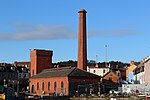G.K. Stothert & Co
Defunct companies based in BristolDefunct shipbuilding companies of the United KingdomDraft topics used in wrong namespaceManufacturing companies based in BristolManufacturing companies disestablished in 1933 ... and 1 more
Manufacturing companies established in 1852

G.K. Stothert & Co was a British engineering company primarily known for shipbuilding and repair founded in 1852 in Bristol, England.
Excerpt from the Wikipedia article G.K. Stothert & Co (License: CC BY-SA 3.0, Authors, Images).G.K. Stothert & Co
Pooles Wharf Court, Bristol Spike Island
Geographical coordinates (GPS) Address External links Nearby Places Show on map
Geographical coordinates (GPS)
| Latitude | Longitude |
|---|---|
| N 51.44884 ° | E -2.61559 ° |
Address
Pooles Wharf Court 1-30
BS8 4PB Bristol, Spike Island
England, United Kingdom
Open on Google Maps








